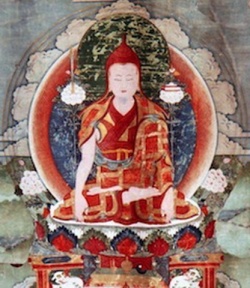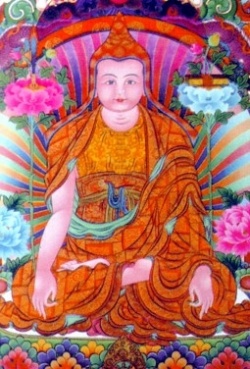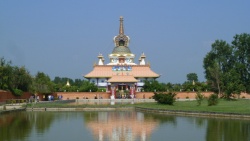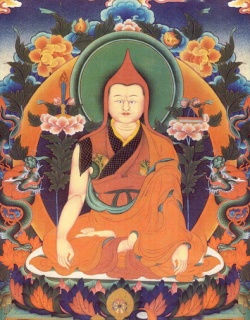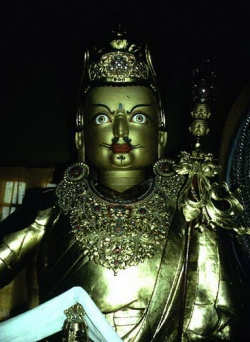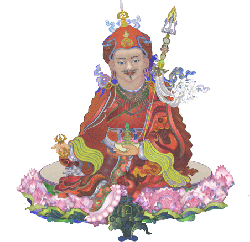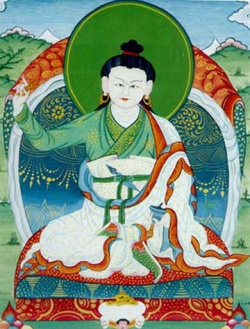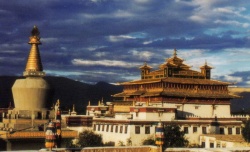Longchenpa
Longchen Rabjampa, Drimé Özer (Wylie: Klong-chen rab-'byams-pa, Dri-med 'od-zer) "Longchenpa" (1308–1364) was a major teacher in the Nyingma school of Tibetan Buddhism.
Along with Sakya Pandita and Je Tsongkhapa, he is commonly recognized as one of the three main manifestations of Manjushri to have taught in Central Tibet.
His major work is the Seven Treasures, which encapsulates the previous 600 years of Buddhist thought in Tibet. Longchenpa was a critical link in the exoteric and esoteric transmission of the Dzogchen teachings.
He was abbot of Samye, one of Tibet's most important monasteries and the first Buddhist monastery established in the Himalaya, but spent most of his life traveling or in retreat. Longchenpa (1308-1363) (Longchen Rabjampa):
Famous Nyingma Dharma King and abbot of Samye Monastery who spent most of his time in retreat.
He wrote the Seven Treasures, an extensive analysis of the Great Perfection tantras, gathering together the heart-essence of the teachings of Guru Padmasambhava, Vimalamitra, and Yeshe Tsogyal.
The date for Longchen Rabjampa's parinirvāṇa (his relinquishing of the appearance of his physically manifest form to others — or, in common parlance, his "death" or "demise") is often incorrectly given as having been during 1363.
However, Longchen Rabjampa did not "die" in 1363; he "died" in 1364.
The discrepancy is due to carelessness in assessing the year, which is, with little trouble, validly interpretable; having been (as implied by some other entries here) a remarkable scholar, his entire life has been (by himself, therefore) well-chronicled.
Longchenpa (Tib. ཀློང་ཆེན་པ་, Wyl. klong chen pa), also known as Longchen Rabjam (Tib. ཀློང་ཆེན་རབ་འབྱམས་, klong chen rab 'byams), ‘Infinite, Vast Expanse of Space’, or Drimé Özer (1308-1364), was one of the most brilliant teachers of the Nyingma lineage.
He systematized the Nyingma teachings in his ‘Seven Treasures’ and wrote extensively on Dzogchen.
He transmitted the Longchen Nyingtik cycle of teachings and practice to Jikmé Lingpa, and it has since become one of the most widely practised of traditions.
The immediate reincarnation of Pema Ledreltsal, Longchenpa is regarded as an indirect incarnation of the princess Pema Sal.
He was born in the Tra Valley of Southern Tibet to master Tenpasung, an adept at both the sciences and the practice of mantra, and Dromza Sonamgyen, who was descended from the family of Dromtönpa Gyalwé Jungné.
Longchenpa was first ordained at the age of eleven and studied extensively with the Third Karmapa, Rangjung Dorje.
He received not only the Nyingma transmissions as passed down in his family, but also studied with many of the great teachers of his day.
He received the combined Kadam and Sakya teachings of the Sutrayana through his main Sakya teacher, Lama Dampa Sonam Gyaltsen, in addition to the corpus of both old and new translation tantras.
At the age of nineteen, Longchenpa entered the famous shedra Sangphu Neuthok, where he acquired great scholarly wisdom.
He later chose to practise in the solitude of the mountains, after becoming disillusioned by the behaviour of some scholars.
During his late twenties two events occurred that were to be of decisive importance in his intellectual and spiritual development.
One was a vision of Guru Padmasambhava and Yeshe Tsogyal, and the other was his meeting with the great Rigdzin Kumaradza.
It was in the mountains that he met Rigdzin Kumaradza, who was travelling from valley to valley leading his students through the most difficult of circumstances.
Together with Rangjung Dorje, Longchenpa accompanied them for two years, during which time he received all of Rigdzin Kumaradza's transmissions and underwent tremendous hardship.
After several years in retreat, Lonchenpa attracted more and more students, even though he had spent nearly all of his life in mountain caves.
During a stay in Bhutan (Tib., Mon), Longchenpa founded several monasteries, including Tharpaling near Bumthang, and fathered two children, his son Tulku Drakpa Özer (b. 1356), going on to become a holder of the Nyingtik lineage.
The events leading up to Longchenpa's parinirvana are recorded in a text known as The Immaculate Radiance which includes these lines:
- The delight of traders at making vast fortunes at sea,
- Or the lords of the gods who vaunt their victory in battle;
- Or of those sages who have entered the rapture of perfect absorption.
- So just as a traveller who sets out on the road when it is time,
- I, Pema Ledrel Tsal, will not remain in this world any longer,
- But will go to dwell in the stronghold of the great bliss of deathlessness.
Legacy
Sogyal Rinpoche writes:
- The figure of Longchen Rabjam stands out as one of the greatest Dzogchen masters in the Nyingma tradition, and amongst the most brilliant and original writers in Tibetan Buddhist literature.
He was the author of over 200 works, of which only about twenty-five survive, and amongst which the Seven Treasuries (Tib. མཛོད་བདུན་ Dzö Dun) and Three Trilogies are most well-known.
It was he who brought together into a cohesive system the teachings of Vima Nyingtik and Khandro Nyingtik, on which he wrote the ‘Three Yangtik’ or Inner Essences.
- As Nyoshul Khen Rinpoche explains: “Kunkhyen Longchenpa’s Seven Treasuries (Dzö Dun) were written to elucidate the extraordinarily profound meaning of the seventeen main Tantras of Dzogpachenpo as well as the teachings of all Nine Yanas.
For the purpose of the actual practice of Dzogchen according to these Tantras, Longchenpa gathered his own termas as well as those of Chetsün Senge Wangchuk (who was later reborn as Jamyang Khyentse Wangpo) and Pema Lédrel Tsal (Longchenpa’s previous incarnation) in the form of the thirteen volume collection known as the Nyingtik Yabshyi.
This Yabshyi is the practice aspect of Longchenpa’s writings, and the basis of the Old Nyingtik.
In it he synthesized the Vima Nyingtik of Vimalamitra and the Khandro Nyingtik of Guru Rinpoche and explained all the practical details in the light of his own realization.”[1]
His Writings
- The Wish Fulfilling Treasury (Tib. ཡིད་བཞིན་མཛོད་, Yishyin Dzö; Wyl. yid bzhin mdzod)
- The Treasury of Pith Instructions (Tib. མན་ངག་མཛོད་, Mengak Dzö; Wyl. man ngag mdzod)
- The Treasury of Dharmadhatu (Tib. ཆོས་དབྱིངས་མཛོད་, Chöying Dzö; Wyl. chos dbyings mdzod)
- The Treasury of Philosophical Tenets (Tib. གྲུབ་མཐའ་མཛོད་, Drubta Dzö; Wyl. grub mtha' mdzod)
- The Treasury of the Supreme Vehicle (Tib. ཐེག་མཆོག་མཛོད་, Tekchok Dzö; Wyl. theg mchog mdzod)
- The Treasury of Word and Meaning (Tib. ཚིག་དོན་མཛོད་, Tsik Dön Dzö; Wyl. tshig don mdzod)
- The Treasury of the Natural State (Tib. གནས་ལུགས་མཛོད་, Neluk Dzö; Wyl. gnas lugs mdzod
)
Trilogy of Dispelling Darkness
- Dispelling Darkness in the Ten Directions (Tib. གསང་སྙིང་འགྲེལ་པ་ཕྱོགས་བཅུ་མུན་སེལ་, gsang snying 'grel pa phyogs bcu mun sel)
- Dispelling Darkness of the Mind (Tib. གསང་སྙིང་སྤྱི་དོན་ཡིད་ཀྱི་མུན་སེལ་, gsang snying spyi don yid kyi mun sel)
- Dispelling Darkness of Ignorance (Tib. གསང་སྙིང་བསྡུས་དོན་མ་རིག་མུན་སེལ་, gsang snying bsdus don ma rig mun sel)
Trilogy of Finding Comfort and Ease
- Finding Comfort and Ease in the Nature of Mind (Tib. སེམས་ཉིད་ངལ་གསོ, Wyl.sems nyid ngal gso)
- Finding Comfort and Ease in Meditation (Tib. བསམ་གཏན་ངལ་གསོ་, Wyl. bsam gtan ngal gso)
- [[Finding Comfort and Ease in the Illusoriness of Things[[ (Tib. [[སྒྱུ་མ་ངལ་གསོ་]], Wyl. sgyu ma ngal gso)
- The Natural Freedom of the Nature of Mind (Tib. སེམས་ཉིད་རང་གྲོལ་, Semnyi Rangdrol)
- The Natural Freedom of Reality (Tib. ཆོས་ཉིད་རང་གྲོལ་, Chönyi Rangdrol)
- The Natural Freedom of Equality (Tib. མཉམ་ཉིད་རང་གྲོལ་, Nyamnyi Rangdrol)
A Collection of Writings (Tib. གསུང་ཐོར་བུ་, Wyl. gsung thor bu)
- Thirty Pieces of Advice from the Heart (Tib. སྙིང་གཏམ་སུམ་ཅུ་པ་, Wyl. snying gtam sum cu pa)
Longchen Rabjampa was born at Gra-phu stod-gron in g.Yo-ru in Eastern dBus in Central Tibet on the eighth day of the second lunar month of the Earth-Male-Ape year (i.e., Friday, 1 March 1308; which was at the beginning of that Tibetan calendrical year)
The date of Longchen Rabjampa's 'parinirvāṇa' was on the eighteenth day of the twelfth lunar month of the Water-Female-Hare year (i.e., Wednesday, 24 January 1364; which was at the end of that Tibetan calendrical year) at O-rgyan-rdzong in Gangs-ri thod-kar, Tibet.
David Germano, in his doctoral thesis on the Tsigdön Dzö (tshigs don mdzod) (one of the Seven Treasuries), frames the brilliance of Longchenpa within the wider discourse of the Dzogchen tradition (found in the Bonpo Zhangzhung and Indo-Tibetan traditions of Buddhism):
- "Although at least five hundred years (800 CE - 1300 CE) of thought, contemplation and composition in this tradition (which may not have been a clearly self-conscious tradition in the beginning) preceded him such that all the major themes, structures,
and terminology were in place prior to his birth (above all in the canonical Seventeen Tantras of the Great Perfection (rgyud bcu bdun)),
it was Longchenpa (1308-1363) who systematically refined the terminology used by the tradition with a series of subtle yet clear distinctions; brilliantly revealed its relationships with mainstream exoteric Buddhist thought;
clarified its internal structure; created from it masterpieces of poetic philosophy remarkable for their aesthetic beauty, philosophical rigor, and overall clarity;
and overall pinpointed the inner quintessence of the tradition with writings that not only systematized every major topic, but also creatively explained each to render crystal clear the unprecedented revolution in the content,
form, and structure of "philosophical" thought in Indo-Tibetan Buddhism that the Great Perfection teachings entail."
Nomenclature, orthography and etymology
Apart from Longchenpa's names given below, he is sometimes referred to by the honorary title "Second Buddha" (Tib. rgyal ba gnyis), a term usually reserved for Guru Padmasambhava and indicative of the high regard in which he and his teachings are held.
Like the Third Karmapa Rangjung Dorje, Rongzompa and Jigme Lingpa, he carried the title "Kunkhyen" (Tibetan; "All-Knowing").
Various forms and spellings of Longchenpa's full name(s), in which 'Longchen' means "Great Expanse", "Vast Space", or "Immense Knowledge":
- Longchen Rabjam (klong chen rab 'byams; realization of vast knowledge)
- Longchen Rabjampa (klong chen rab 'byams pa)
- Longchenpa Drimé Özer (klong chen pa dri med 'od zer)
- Künkhyen Longchenpa (kun mkhyen klong chen pa; the omniscient Longchenpa)
- Künkhyen Longchen Rabjam (kun mkhyen klong chen rab 'byams)
- Künkhyen Chenpo (kun mkhyen chen po; Omniscient Great One)
- Künkhyen Chenpo Drimé Özer (kun mkhyen chen po dri med 'od zer)
- Künkhyen Chökyi (kun mkhyen chos kyi rgyal po; [[All-knowing [harma King]])
- Gyalwa Longchen Rabjam (rgyal ba klong chen rab 'byams)
- Gyalwa Longchen Rabjam Drimé Özer (rgyal ba klong chen rab 'byams dri med 'od zer)
Biography
A reincarnation of Pema Ledrel Tsal, as such Longchenpa is regarded as an indirect incarnation of the princess Pema Sal.
He was born to master Tenpasung,
an adept at both the sciences and the practice of mantra, and Dromza Sonamgyen, who was descended from the family of Dromton Gyelwie Jungne.
Legend states that at age five, Longchenpa could read and write and by age seven his father began instructing him in Nyingma tantras.
Longchenpa was first ordained at the age of twelve and studied extensively with the Third Karmapa, Rangjung Dorje.
He received not only the Nyingma transmissions as passed down in his family, but also studied with many of the great teachers of his day without regard to sect.
He thus received the combined Kadam and Sakya teachings of the Sutrayana through his main Sakya teacher, Palden Lama Dampa Sonam Gyaltsen, in addition to the corpus of both old and new translation tantras.
At the age of nineteen, Longchenpa entered the famous shedra (monastic college) Sangpu Neutok (Wylie: gSang-phu Ne'u-thog), where he acquired great scholarly wisdom.
He later chose to practice in the solitude of the mountains, after becoming disgusted by the unpleasant behavior of certain scholars.
When he was in his late twenties two events occurred that were to be of decisive importance in his intellectual and spiritual development.
One was a vision of Guru Padmasambhava and his consort Yeshe Tsogyal.
The other happened in his twenty-ninth year, his meeting with the great mystic Rigdzin Kumaradza (alt.
Kumaraja) from whom he received the Dzogchen empowerment and teachings in the mountains, the uplands of Yartökyam at Samye where he was traveling from valley to valley with his students under the most difficult of circumstances.
Dudjom Rinpoche (1904–1987) et al. (1991: p. 579) held that just prior to the arrival of Longchenpa, Kumaraja related to his disciples:
- "Last night I dreamt that a wonderful bird, which announced itself to be a divine bird, came with a large flock in attendance, and carried away my books in all directions.
Therefore, someone will come to hold my lineage."
Kumaraja accepted no outer tribute from Longchenpa for the teachings he received as Kumararaja through his supernormal cognitive powers discerned that Longchenpa was blameless and had offered his tribute internally.
Together with Rangjung Dorje, Longchenpa accompanied Kumaraja and his disciples for two years, during which time he received all of Rigdzin Kumaradza's transmissions.
Through the efforts of these three, the diverse streams of the "Innermost Essence" (nying thig) teachings of Dzogchen were brought together and codified into one of the common grounds between the Nyingma and Karma Kagyud traditions.
After several years in retreat, Longchenpa attracted more and more students, even though he had spent nearly all of his life in mountain caves. During a stay in Bhutan (Tib., Mon),
Longchenpa fathered a daughter and a son, of which the latter, Trugpa Odzer (b. 1356), also became a holder of the Nyingtig lineage.
A detailed account of the life and teachings of Longchenpa is found in Buddha Mind by Tulku Thondup Rinpoche and in A Marvelous Garland of Rare Gems by Nyoshul Khenpo.
Pema Lingpa the famous terton (finder of sacred texts) of Bhutan is regarded as the immediate reincarnation of Longchenpa.
Works
Longchenpa is widely considered the single most important writer on the Dzogchen teachings.
He is credited with more than 250 works, both as author and compiler, among which are the famous Seven Treasures (mdzod bdun), the Trilogy of Natural Freedom (rang grol skor gsum), the Trilogy of Natural Ease (ngal gso skor gsum),
his Trilogy of Dispelling Darkness, and his compilation - plus commentaries - of the Nyingtig Yabshi.
He is also a commentator of the Kunyed Gyalpo Tantra (Tib., kun byed rgyal po'i rgyud; "The King Who Creates Everything"), a text belonging to the Mind Class (Tib., sems sde) of the Ati Yoga Inner Tantras.
As scholar Jacob Dalton summarizes,
- His foremost writings were gathered into several collections:
The Mdzod bdun (Seven Treasuries) are his most famous works, presenting the whole of Buddhist thought from a snying thig viewpoint;
the Ngal gso skor gsum (Resting at Ease Trilogy) and theRang grol skor gsum (Natural Freedom Trilogy) provide in-depth introductions to Rdzogs chen;
the Mun sel skor gsum (Dispelling the Darkness Trilogy) are three commentaries on the Guhyagarbha Tantra;
and the Snying thig ya bzhi (Seminal Quintessence in Four Parts) is a redaction of his three snying thig commentaries together with their predecessors, the Vima snying thig and the Mkha' 'gro snying thig.
Longchenpa combined the teachings of the Vima Nyingtig lineage with those of the Khandro Nyingtig, thus preparing the ground for the fully unified system of teachings that became known as the Longchen Nyingthig (by Jigme Lingpa).
Translations in English
- Dowman, Keith, Old Man Basking In the Sun: Longchenpa's Treasury of Natural Perfection, Vajra Publications, 2006
- Guenther, H.V., Kindly Bent to Ease Us [trans. of The Trilogy of Finding Comfort and Ease (Ngal-gso-skor-gsum), vols. 1-3, Dharma Publishing, 1975-6
- Guenther, H.V. and the Yeshe De Translation Group, Now That I Come to Die [trans. of the parting injunctions (zhal-chems gnad-kyi me-long)], Dharma Publishing, 2007
- Klong-chen rab-'byams-pa, Looking Deeper: A Swan's Questions and Answers, translated by Herbert V. Guenther, Timeless Books, 1983
- Rabjam, Longchen (Longchenpa) (2000). You Are the Eyes of the World. (trans of kun byed rgyal po by Kennard Lipman & Merrill Peterson and with an introduction by Namkhai Norbu). Snow Lion Publications; Revised Edition.
- Longchen Rabjampa, 'The Four-Themed Precious Garland: An Introduction to Dzogchen, with commentaries by Dudjom Rinpoche and Beru Khyentse Rinpoche; translated by Alexander Berzin, LTWA, 1978
- Longchen Rabjam (author), Richard Barron (trans): The Precious Treasury of the Basic Space of Phenomena (Chöying Dzöd). Padma Publishing
- Longchen Rabjam (author), Richard Barron (trans): A Treasure Trove of Scriptural Transmission: A Commentary on the Precious Treasury of the Basic Space of Phenomena. Padma Publishing (2001)
- Longchen Rabjam (author), Richard Barron (trans): Precious Treasury of the Way of Abiding. Padma Publishing (1998)
- Longchen Rabjam (author), Richard Barron (trans): The Precious Treasury of Philosophical Systems (Drupta Dzöd): Padma Publishing (2008)
- Longchen Rabjam (author), Richard Barron (trans): The Precious Treasury of Pith Instructions (Man-ngak Dzöd): Padma Publishing (2007)
- Longchen Rabjam, The Practice of Dzogchen, translated by Tulku Thondup, Snow Lion, 2002
- Longchenpa, Chögyal Namkhai Norbu, Longchenpa's Advice from the Heart, Shang Shung Publications, 2008

